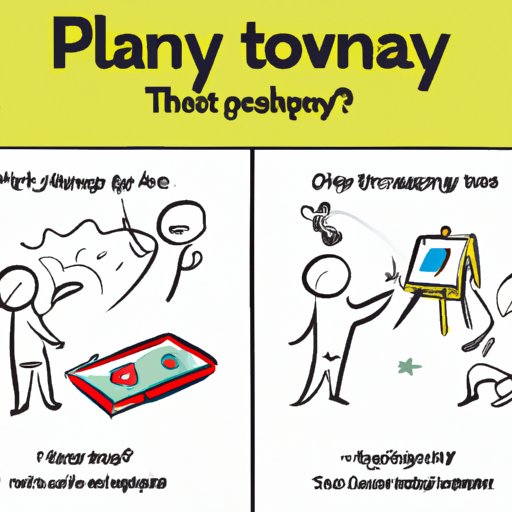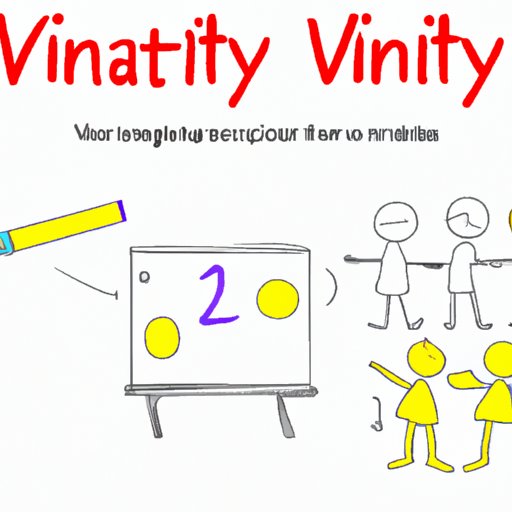
I. Introduction
Are you looking for a fun and creative way to spend time with friends, family, or coworkers? Look no further than Pictionary! This classic drawing game has been a popular pastime for decades, and for good reason. It’s simple to set up, easy to learn, and highly customizable. In this article, we’ll show you how to play Pictionary like a pro, with tips and tricks for winning, creative ways to spice up the game, and ideas for adapting it for kids and team building activities. Let’s get started!
II. 8 Easy Steps to Playing Pictionary Like a Pro
Before you can start drawing and guessing, you’ll need to set up the game properly. Here are eight easy steps to follow:
- Divide players into two or more teams (at least two players per team).
- Prepare the drawing materials: a whiteboard or a large pad of paper, markers or colored pencils, and a timer (optional).
- Select a theme or category for each round of the game (e.g. movies, animals, famous landmarks).
- Assign a player from one team to draw a clue based on the selected theme/category.
- The player must draw without speaking, using only visual cues to convey the word or phrase to their team members.
- If their team correctly guesses the clue before time runs out, they score a point.
- If they don’t guess it in time, they lose their turn, and the other team gets a chance to draw a clue.
- The game continues until one team reaches a predetermined number of points, usually 10-20.
While these rules are straightforward, there are some tips and tricks you can use to improve your chances of winning. For example:
- Practice your drawing skills beforehand, especially if you’re not confident in your abilities.
- Use simple shapes, symbols, and lines to convey your message quickly and clearly.
- Focus on the key features of the word or phrase, such as its color, size, shape, or location.
- Pay attention to your teammates’ reactions and adjust your drawing style accordingly.
- Use humor, puns, or cultural references to make your clues more memorable and entertaining.
- For guessing, use deduction, context clues, and process of elimination to narrow down your options.
- Don’t be afraid to take risks and think outside the box.
III. The Ultimate Guide to Pictionary: Tips and Tricks to Win Every Game
If you want to take your Pictionary skills to the next level, here are some advanced strategies to consider:
- Practice drawing different types of objects, such as abstract concepts, emotions, sounds, or foreign words.
- Study the different categories and subcategories of Pictionary words, and become familiar with their common features, associations, and contexts.
- Develop a quick drawing style that allows you to capture the essence of the word or phrase in a few strokes.
- Use visual metaphors, similes, or analogies to convey the meaning indirectly.
- If you’re guessing, ask strategic questions that eliminate possible answers or confirm suspicions (e.g. “Is it a person?” “Is it a place?” “Does it rhyme with…?”).
- Observe the other team’s drawing style and look for patterns, clues, or hidden meanings.
- Don’t reveal your method of deduction or analysis to the other team, as they may use it against you.
- Stay calm, focused, and positive, even if you’re losing.
By following these tips, you’ll not only improve your chances of winning but also enhance your creativity, communication, and problem-solving skills.
IV. Pictionary with a Twist: Creative Ways to Play the Classic Game
If you’re tired of playing the same old Pictionary rules, here are some fun variations to try:
- Puzzle Pictionary: Instead of drawing the entire word or phrase, draw it in jigsaw puzzle pieces that reveal one more clue with each successive line.
- Picture Consequences: Draw part of a picture, then pass it to the other team to complete.
- Reverse Pictionary: Instead of drawing a word, describe a picture.
- Blind Pictionary: Draw with your eyes closed or while blindfolded.
- Cross-category Pictionary: Combine two or more categories into one round, such as “Animals in History” or “Movie Foods.”
- Speed Pictionary: Set a time limit of 30 seconds or less for each clue.
Feel free to come up with your own variations and share them with your group. The only limit is your imagination!

V. Pictionary for Kids: How to Adapt the Game for Younger Players
If you’re playing with kids or want to make the game more accessible to all ages, here are some tips:
- Select simple and familiar words that kids can recognize and spell, such as colors, animals, and foods.
- Make the themes more visual and less abstract, such as cartoons, toys, or nature.
- Allow the kids to draw in teams or pairs, or give them extra time to draw and guess.
- Include more rewards and positive feedback, such as stickers, high-fives, or compliments.
- Use a simpler scoring system that rewards effort and participation more than accuracy.
Remember to adjust the rules and pace of the game to suit the needs and interests of your little players. You may be surprised at how creative and enthusiastic they can be!
VI. Breaking the Ice with Pictionary: How to Use the Game for Team Building Activities
If you’re looking for a fun and interactive way to foster collaboration, communication, and team spirit among your group, Pictionary can be a great tool. Here are some ideas for team building exercises:
- Blind Pictionary: Draw with your eyes covered, or while standing behind a barrier, and have your teammates guide you.
- Rapid-fire Pictionary: Set a timer for 10-20 seconds per clue and have each team member draw and guess in succession.
- Team Pictionary: Split into two or more teams, assign one player from each team to draw a clue simultaneously, and see which team guesses correctly first.
- Verbal Pictionary: Replace drawing with verbal descriptions, and have the team members take turns describing the word or phrase to their partners.
- Collaborative Pictionary: Assign one clue to the whole team, and have each member draw one part of the picture until it’s complete.
Make sure to debrief and reflect on the experience afterward, and ask questions such as:
- What was challenging about the exercise?
- What did you learn about your teammates’ strengths and weaknesses?
- How did you communicate and collaborate during the game?
- What could you do differently or better next time?
By using Pictionary as a team building tool, you’ll not only have fun but also improve your interpersonal skills and teamwork abilities.
VII. The Science of Drawing: Why Pictionary is Good for Your Brain
Believe it or not, playing Pictionary can have numerous cognitive benefits for your brain. Here are some of the ways it can improve your mental abilities:
- Visual-spatial reasoning: Drawing requires you to visualize shapes, sizes, and proportions and translate them onto paper. This improves your ability to mentally rotate objects, understand perspectives, and solve puzzles.
- Creativity: Drawing has been shown to stimulate the brain’s right hemisphere, which is responsible for creativity, intuition, and emotions. It can help you generate new ideas, think outside the box, and express yourself more freely.
- Problem-solving: Drawing and guessing in Pictionary require you to use deduction, analysis, and critical thinking skills to arrive at the correct answer. This can improve your logical reasoning, decision-making, and intellectual flexibility.
- Memory: The act of drawing and guessing, as well as the visual and auditory cues associated with it, can enhance your short-term and long-term memory retention. This can be particularly beneficial for learning new vocabulary, concepts, or skills.
So next time you’re playing Pictionary, remember that you’re not just having fun – you’re also exercising your brain!
VIII. Conclusion
In conclusion, we hope this ultimate guide to Pictionary has given you some useful insights and inspiration for enjoying this classic game to the fullest. Whether you’re playing with friends, family, coworkers, or strangers, there’s always something new to discover and experiment with in Pictionary.




